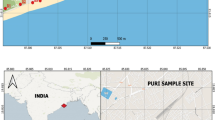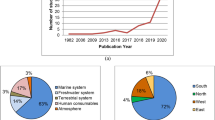Abstract
The main aim of this study is to determine the water-soluble species of PM10 (particles having an aerodynamic diameter less than 10 μm) in urban and rural sites of Rajnandgaon district, central India, in 2009. The samples were collected on quartz fiber filters and analyzed for the major water-soluble ions Cl−, \({\text{NO}}_{3}^{ - }\), \({\text{SO}}_{4}^{{2 - }}\), \({\text{NH}}_{4}^{ + }\), Na+, K+, Mg2+ and Ca2+ parameters, employing ion chromatograph. These species show large spatial and temporal variations. On urban site, the ambient PM10 concentration has been observed to be the highest 167 ± 64 μg m−3 (winter) followed by 141 ± 65 μg m−3 (post-monsoon), 112 ± 53 μg m−3 (pre-monsoon) and lowest 34 ± 13 μg m−3 (high monsoon), whereas in rural background, the PM10 concentration was highest 153 ± 54 μg m−3 (winter) followed by 122 ± 53 μg m−3 (post-monsoon), 102 ± 39 μg m−3 (pre-monsoon) and lowest 32 ± 11 μg m−3 (high monsoon). The measured concentrations were excess of annual averages specified by the Indian National Ambient Air Quality Standards of PM10 60 μg m−3. Simultaneously, the measurement of organic carbon (OC) and elemental carbon (EC) was also taken. The annual concentration of OC and EC in urban site was found to be 5.9 and 4.8 μg m−3, but in the rural site, the concentration was 3.11 and 2.78 μg m−3 with OC/EC ratios 1.90 and 1.73 in urban and rural sites, respectively. Higher levels were obtained at urban site as compared to rural site. This suggested that the urban site exhibited a more serious climatic impact on the background air.






Similar content being viewed by others
References
Ambade B (2012) Physico-chemical assessment of rain fog and runoff water. Lap-Lambert Academic Publishing, Germany ISBN: 978-3-659-30271-8
Ambade B (2013) Characterization and source of fog water contaminates in central India. Nat Hazards. doi:10.1007/s11069-013-0892-7
Ambade B, Ghosh S (2013) Characterization of PM10 in the ambient air during Deepawali festival of Rajnandgaon district India. Nat Hazards 69(1):589–598
Bhaskar BV, Mehta VM (2010) Atmospheric particulate pollutants and their relationship with meteorology in Ahmedabad. Aerosol Air Qual Res 10:301–315
Birch ME, Cary RA (1996) Elemental carbon-based method for monitoring occupational exposures to particulate diesel exhaust. Aerosol Sci Technol 25:221–241
Borja-Aburto VH, Castillejos M, Gold DR (1998) Mortality and ambient fine particles in southwest Mexico City, 1993–1995. Environ Health Perspect 106:849–855
Cao JJ, Lee SC, Ho KF, Zhang XY, Zou SC, Fung KK, Chow JC, Watson JG (2003) Characteristics of carbonaceous aerosol in Pearl River Delta region, China during 2001 winter period. Atmos Environ 37(11):1451–1460
Census of India 2001 (2001) http://www.censusindia.gov.in/towns/chh_towns.pdf. Accessed 10 May 2011
Chen L, Mengersen KL, Tong S (2007) Spatiotemporal relationship between particle air pollution and respiratory emergency hospital admissions in Brisbane, Australia. Sci Total Environ 373(1):57–67
Delumyea RG, Chu LC, Macias ES (1980) Determination of elemental carbon component of soot in ambient aerosol samples. Atmos Environ 14:647–652
Duan F, Liu X, Yu T, Cachier H (2004) Identification and estimate of biomass burning contribution to the urban aerosol organic carbon concentrations in Beijing. Atmos Environ 38:1275–1282
Franchini M, Mannucci PM (2007) Short-term effects of air pollution on cardiovascular diseases: outcomes and mechanisms. J Thromb Haemost 5(11):2169–2174
Giri B, Patel KS, Jaiswal NK, Sharma S, Ambade B, Wang W, Simonich SLM, Simoneit BRT (2013) Composition and sources of organic tracers in aerosol particles of industrial central India. Atmos Res 120–121:312–324
He KB, Yang FM, Ma YL, Zhang Q, Yao XH, Chan CK, Cadle S, Chan T, Mulawa P (2001) The characteristics of PM2.5 in Beijing, China. Atmos Environ 35:4959–4970
Horvath H (1993) Atmospheric light absorption: a review. Atmos Environ 27A:293–317
Hu M, Ling YH, Zhang YH, Wang M, Kim YP, Moon KC (2002) Seasonal variation of ionic species in fine particles at Qingdao, China. Atmos Environ 36:5853–5859
IPCC (2007) Climate change 2007: The physical science basis. Contribution of working group I to the fourth assessment report of the IPCC (ISBN 978 0521 88009-1 Hardback; 978-0521 70596-7Paperback)
Karar K, Gupta AK, Kumar A, Biswas AK (2006) Characterization and identification of the sources of Chromium, Zinc, Lead, Cadmium, Nickel, Manganese, and Iron in PM10 at two sites of Kolkata, India. Environ Monit Assem 120:347–360
Kendall M, Duarte A, Rocha-Santos T, Hamilton R, Williams I (2002) Airborne particulate-associated polyaromatic hydrocarbons, n alkanes, elemental and organic carbon in three European cities. J Environ Monit 4:890–896
Kido M, Osada K, Matsunaga K, Iwasaka Y (2001) Diurnal variation of ionic aerosol species and watersoluble gas concentrations at a high-elevation site in the Japanese Alps. J Geophys Res 106:17335–17345
Kim YP, Moon K-C, Lee JH, Baik NJ (1999) Concentrations of carbonaceous species in particles at Seoul and Cheju in Korea. Atmos Environ 33:2751–2758
Kumar R, Srivastava SS, Kumari KM (2007) Characteristics of aerosols over urban and suburban site of semiarid region in India: seasonal and spatial variations. Aerosol Air Qual Res 7:531–549
Lee T, Yu XY, Ayres B, Kreidenweis SM, Malm WC, Collett JL (2008) Observations of fine and coarse particle nitrate at several rural locations in the United States. Atmos Environ 42:2720–2732
Li YH, Yuan D, Kan HD et al (2003) Progress in epidemiological study on urban particulate air pollution and mortality. J Occup Env Med 20(1):47–49 (in Chinese)
Marenco P, Bonasoni F, Calzolari M, Ceriani M, Chiari J, Cristofanelli P (2006) Characterization of atmospheric aerosols at Monte Cimone, Italy, during summer 2004: source apportionment and transport mechanisms. J Geophys Res 111:D24202. doi:10.1029/2006JD007145
Pathak RK, Wu WS, Wang T (2009) Summertime PM2.5 ionic species in four major cities of China: nitrate formation in an ammonia-deficient atmosphere. Atmos Chem Phys 9:1711–1722
Pey J, Pérez N, Castillo S, Viana M, Moreno T, Pandolfi M, López- Sebastián JM, Alastuey A, Querol X (2009) Geochemistry of regional background aerosols in the western Mediterranean. Atmos Res 94:422–435
Pope CA III, Burnett RT, Thun MJ et al (2002) Lung cancer, cardiopulmonary mortality, and long-term exposure to fine particulate air pollution. J Am Med Assoc 287(9):1132–1141
Qian Z, He Q, Lin H, Kong L, Liao D, Dan J, Bentley CM, Wang B (2007) Association of daily cause-specific mortality with ambient particle air pollution in Wuhan, China. Environ Res 105(3):380–389
Rengarajan R, Sarin MM, Sudheer AK (2007) Carbonaceous and inorganic species in atmospheric aerosols during wintertime over urban and high-altitude sites in North India. J Geophys Res Atmos 112, art. no. D21307
Ruellan S, Cachier H (2001) Characterization of fresh particulate vehicular exhausts near a Paris high flow road. Atmos Environ 35:453–468
Salam A, Bauer H, Kassin K, Ullah SM, Puxbaum H (2003a) Aerosol chemical characteristics of a mega-city in Southeast Asia (Dhaka, Bangladesh). Atmos Environ 37:2517–2528. doi:10.1016/S1352-2310(03),00135-3
Salam A, Bauer H, Kassin K, Ullah SM, Puxbaum H (2003b) Aerosol chemical characteristics of an island site in the Bay of Bengal (Bhola, Bangladesh). J Environ Monit 5(3):483–490
Salma I, Chi X, Menhaut W (2004) Elemental and organic carbon in urban canyon and background environments in Budapest, Hungary. Atmos Environ 38:27–36
Schwartz J, Dockery DW, Neas LM (1996) Is daily mortality associated specifically with fine particles? J Air Waste Manag Assoc 46:927–939
Seinfeld JH, Pandis SN (1998) Atmospheric chemistry and physics. Wiley, New York
Shen ZX, Cao JJ, Arimoto R, Han ZW, Zhang RJ, Han YM, Liu SX, Okuda T, Nakao S, Tanaka S (2009) Ionic composition of TSP and PM2.5 during dust storms and air pollution episodes at Xi’an, China. Atmos Environ 43:2911–2918
Smith DJT, Harrision RM, Luhana L, Casimiro AP, Castro LM, Tariq MN, Hayat S, Quraishi T (1996) Concentrations of particulate airborne polycyclic aromatic hydrocarbons and metals collected in Lahore, Pakistan. Atmos Environ 30:4031–4040
Tan JH, Duan JC, Chen DH, Wang XH, Guo SJ, Bi XH, Sheng GY, He KB, Fu JM (2009) Chemical characteristics of haze during summer and winter in Guangzhou. Atmos Res 94:238–245
Tsuboi K, Hosomi T, Dokiya Y, Tsutsumi Y, Yanagisawa K, Tanaka S (1996) Chemical species in aerosol, gases and precipitation at summit of Mt. Fuji. J Aerosol Res 11:226–234 (in Japanese)
Venkataraman C, Reddy CK, Josson S, Reddy MS (2002) Aerosol size and chemical characteristics at Mumbai, India, during the INDOEX-IFP (1999). Atmos Environ 36:1979–1991
Wang Y, Zhuang G, Tang A, Yuan H, Sun Y, Chen S (2005) The ion chemistry and the source of PM2.5 aerosol in Beijing. Atmos Environ 39:3771–3784
Watson JG (2002) Visibility: science and regulation. Japca J Air Waste Ma 52:628–713
Yao XH, Chak KC, Fang M, Cadle S, Chan T, Mulawa P, He KB, Ye BM (2002) The water-soluble ionic composition of PM2.5 in Shanghai and Beijing, China. Atmos Environ 36:4223–4234
Yu JZ, Tung JWT, Wu AWM, Lau AKH, Louie PK-K, Fung JCH (2004) Abundance and seasonal characteristics of elemental and organic carbon in Hong Kong PM10. Atmos Environ 38:1511–1521
Zhang T, Cao JJ, Tie XX, Shen ZX, Liu SX, Ding H, Han YM, Wang GH, Ho KF, Qiang J, Li WT (2011) Water-soluble ions in atmospheric aerosols measured in Xi’an, China: seasonal variations and sources. Atmos Res 102:110–119
Author information
Authors and Affiliations
Corresponding author
Rights and permissions
About this article
Cite this article
Ambade, B. Characterization of PM10 over urban and rural sites of Rajnandgaon, central India. Nat Hazards 80, 589–604 (2016). https://doi.org/10.1007/s11069-015-1985-2
Received:
Accepted:
Published:
Issue Date:
DOI: https://doi.org/10.1007/s11069-015-1985-2




